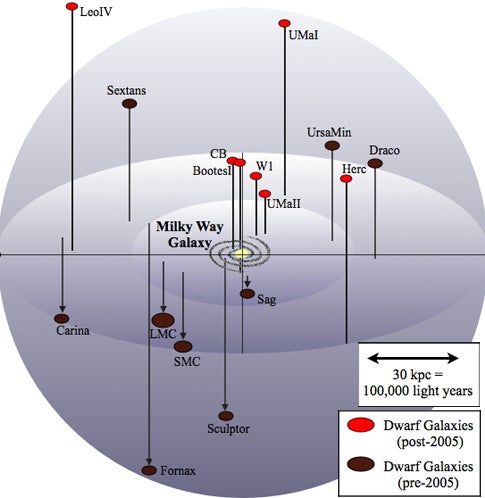In an attempt to resolve the “Missing Dwarf Galaxy” problem, two astronomers used the W. M. Keck Observatory in Hawaii to study a population of the darkest, most lightweight galaxies known, each containing 99% dark matter. The findings suggest the “Missing Dwarf Galaxy” problem is not as severe as previously thought, and may have been solved completely.
“It seems that very small, ultra-faint galaxies are far more plentiful than we thought,” said Marla Geha, co-author of the study and a Plaskett Institute of Astrophysics in Canada. “If you asked me last year whether galaxies this small and this dark existed, I would have said no. I’m astonished that so many tiny, dark matter-dominated galaxies have now been discovered.”
The Missing Dwarf Galaxy puzzle comes from a prediction of the “Cold Dark Matter” model, which explains the growth and evolution of the universe. It predicts large galaxies like the Milky Way should be surrounded by a swarm of up to several hundred smaller galaxies known as “dwarf galaxies.” However, until recently, only 11 such companions were known to be orbiting the Milky Way. To explain this large discrepancy, theorists suggested that while hundreds of dwarf galaxies near the Milky Way may indeed exist, the majority might have few, if any, stars. If so, the galaxies would be comprised almost entirely of dark matter-a mysterious type of matter that has gravitational effects on ordinary atoms, but which does not produce any light. But proving the existence of a large number of nearly invisible galaxies seemed problematic, until now.
Josh Simon, a Millikan Postdoctoral Scholar at the California Institute of Technology, and Geha used the 10-meter Keck II telescope with the DEIMOS spectrograph to conduct follow-up studies of eight new dwarf galaxies first discovered with the Sloan Digital Sky Survey. The results enabled the duo to calculate precisely the total mass of each galaxy. To their surprise, each system was among the smallest ever measured, more than 10,000 times smaller than the Milky Way.
Numerous, repeated measurements of 814 stars in the eight dwarf galaxies were obtained at W. M. Keck Observatory. The stars were found to be moving much slower than stars in any other known galaxy (about 4 to 7 km/sec.) For comparison, the Sun orbits the center of the Milky Way at a speed of about 220 km/sec. In all, the astronomers measured precise speeds for 18 to 214 stars in each galaxy, about three times more stars per galaxy than any previous study.
“This is a significant paper,” said Taft Armandroff, director of the W. M. Keck Observatory, whose own research includes the study of dwarf galaxies. “It is a compelling example of how large, ground-based telescopes can precisely measure the orbits of distant stars on the sky to just a few kilometers per second. I expect DEIMOS will soon tell us about the chemical composition of these stars to help us better understand how star formation takes place in such small galaxies.”
Some parameters of the Cold Dark Matter theory can now be updated to match observed conditions in the local universe. Based on the masses measured for the new dwarf galaxies, Simon and Geha concluded the fierce ultraviolet radiation given off by the first stars, which formed just a few hundred million years after the Big Bang, may have blown all of the hydrogen gas out of the dwarf galaxies forming at that time. The loss of gas prevented the galaxies from creating new stars, leaving them very faint, or in many cases completely dark. When this effect is included in theoretical models, the numbers of expected and observed dwarf galaxies agree.
“One of the implications of our results is that up to a few hundred completely dark galaxies really should exist in the Milky Way’s cosmic neighborhood,” said Geha. “If the Cold Dark Matter model is correct they have to be out there, and the next challenge for astronomers will be finding a way to detect their presence.”
Because the Sloan Digital Sky Survey only covered about 25 percent of the sky, future surveys of the remainder of the sky are expected to discover as many as 50 more dark matter dominated dwarf galaxies orbiting the Milky Way. Telescopes for one such survey, the Pan-STARRS project on Maui, are now under construction.
The paper, “Kinematics of the Ultra-Faint Milky Way Satellites: Solving the Missing Satellite Problem,” will be published in the November 10 issue of the Astrophysical Journal.












